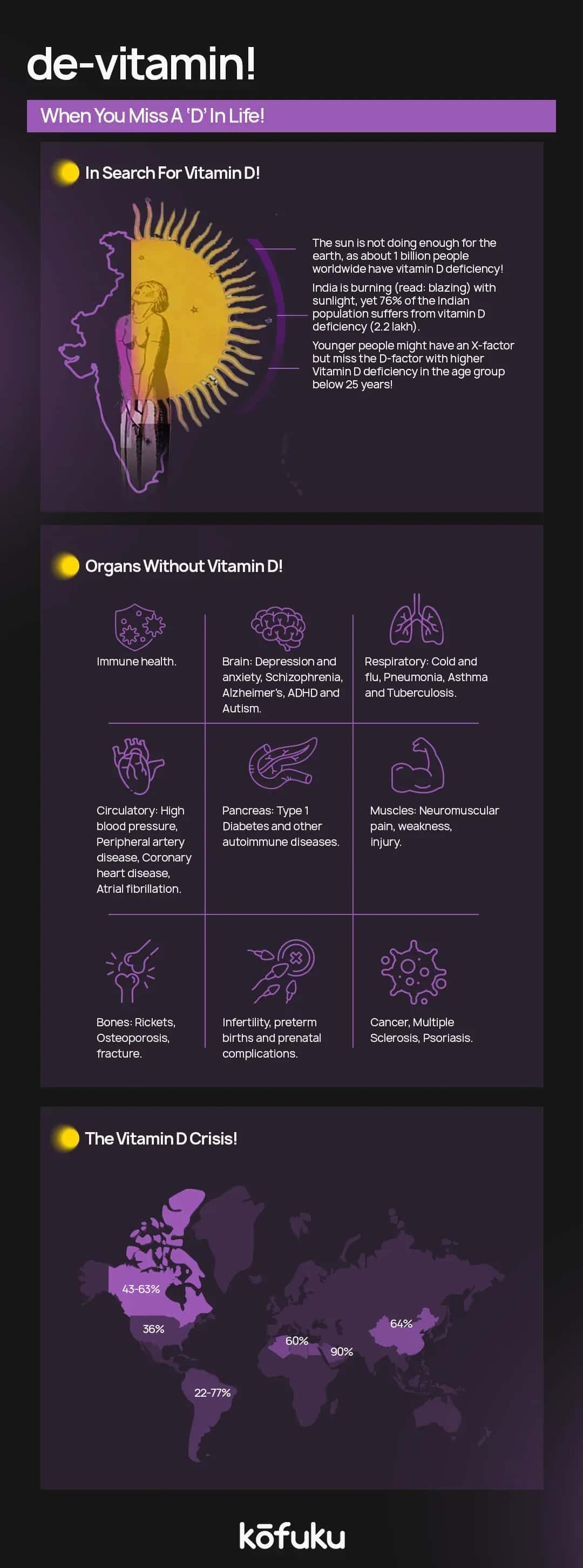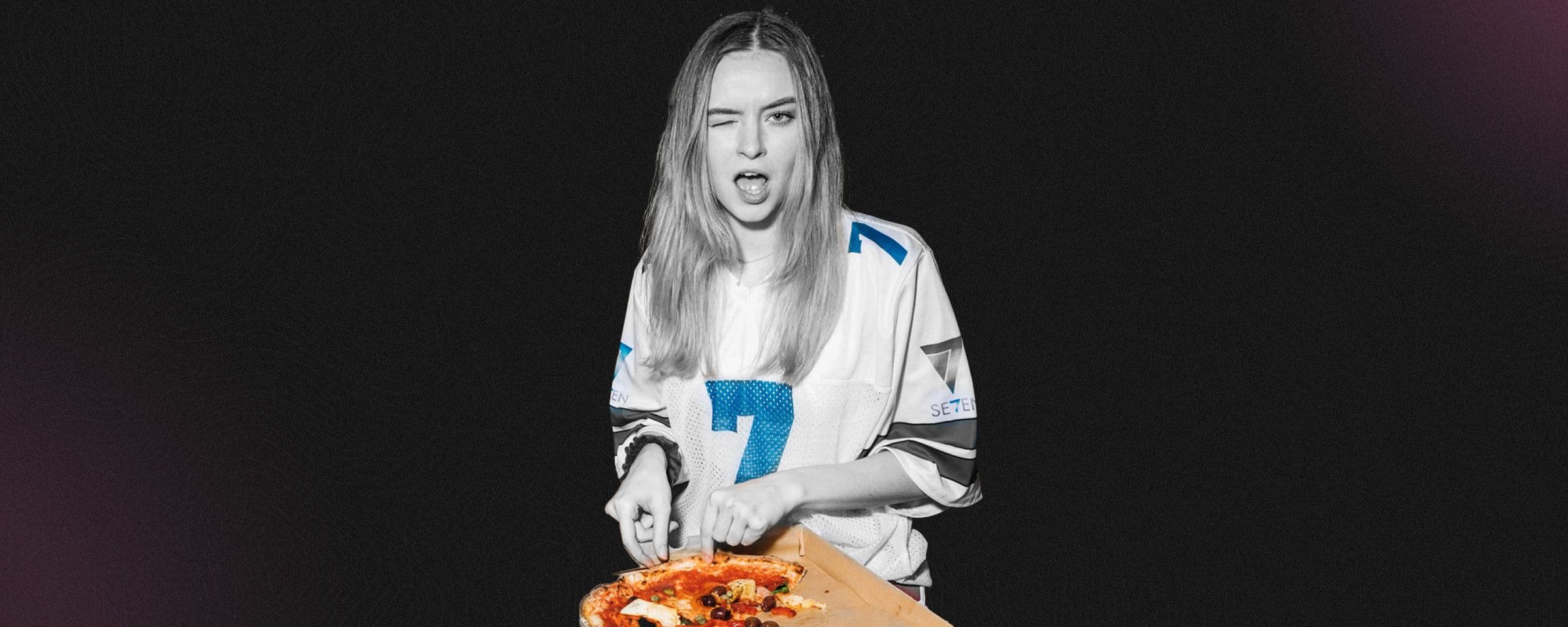Vitamin D3 Deficiency: Symptoms and Vegetarian Foods Rich in Vitamin D

Introduction
Vitamin D, also known as the ‘sunshine vitamin’, is vital for our health. It helps improve bone health, boosts immunity and also elevates mood. Studies show that around 76% of Indians have a vitamin D deficiency, and one of the best ways to address this deficiency is to include vitamin D-rich foods in your diet.
For vegetarians, the challenge is greater. Many natural sources of vitamin D, like fatty fish, liver and eggs, are off the menu. This is why understanding of vitamin D-rich foods from plant-based or fortified sources becomes essential.
Consider this blog a nudge to include vitamin D in the diet and make necessary lifestyle adjustments. In this blog, we will explore what vitamin D is, how deficiency shows up, and 10 vegetarian foods that are rich in vitamin D. Along with this, you will also learn ways to include these vitamin D-rich foods in your daily meals.
Despite its name, vitamin D functions more like a hormone than a typical vitamin. It exists in two forms: D2(ergocalciferol) and D3(cholecalciferol). While both D2 and D3 help in improving vitamin D levels, D3 is generally considered more effective.
The Silent Epidemic of Vitamin D Deficiency
From boosting immunity to supporting strong bones and mental well-being, the vitamin D benefits are wide-ranging. Though sunlight is the natural source of vitamin D, it's not enough, especially for people who live in hilly and colder climates and spend more time indoors.
For vegetarians, the challenge is greater. So, what can you do if you are a vegetarian and want to maintain good levels of vitamin D?
Here are natural, vegetarian sources of vitamin D, how to maximise intake, how to recognise vitamin D deficiency and much more.
Vitamin D benefits include:
- Promotes the development of strong bones and teeth
- Improves bone health
- Assists in the proper functioning of the immune system
- Improves muscle strength and function
- Controls blood pressure
- Controls cholesterol
- Regulates cardiac muscle function
- Control Asthma
- Decreases the chance of long-term illness
- Improves mood
- Supports the upkeep of cellular operations
- Promotes general well-being
Vitamin D3 Deficiency Symptoms
- Fatigue
- Insomnia
- Bone pain
- Depression
- Hair loss
- Weakness in muscles
- Loss of appetite
- Compromised immune system
- Pale skin
Vitamin D Deficiency Causes
Several factors contribute to vitamin D3 deficiency, including:
- Limited exposure to the sun due to indoor lifestyle, clothing or sunscreen use
- Darker skin, which reduces synthesis
- Ageing
- Poor diet

The Top 10 Vegetarian Vitamin D Rich Foods
Let’s look at the most effective vitamin D sources in a vegetarian diet. Some are naturally occurring, while others are fortified yet all are effective and promote overall well-being.
Mushrooms (UV exposed or Wild)
Certain mushrooms, such as shiitake, maitake and especially UV-exposed white mushrooms, can synthesise vitamin D2 when exposed to sunlight, just as our skin produces vitamin D.
Why They Matter: Mushrooms are one of the true plant-based, vitamin D-rich foods.
How to Eat: Grill, stir fry, or add to soups and salads.
Bonus: They are also a part of the vitamin D vegetables category.
Fortified Plant Milks (Almond, Soy, Oat, Rice)
Many plant-based milks are fortified with vitamins D2 or D3. One glass of these milks can provide 15-25% of your daily requirement.
Why They Matter: Milks such as almond, soy and oat are a daily staple of many vegans.
How to Eat: Smoothies and cereals are the best way to consume fortified milks but you can also use these milks, as a dairy substitute.
Bonus: Essential vitamin D source every vegetarian should include.
Fortified Cereal and Oatmeal
Many people love cereal and oatmeal for breakfast, and breakfast cereals, especially wholegrain and bran types, are often fortified with vitamin D along with iron and B12.
Why They Matter: They are easy and convenient to make.
How to Eat: Pair it with fortified milk and fruit for a nutrient-rich breakfast.
Fortified Orange Juice
Not all juices are created equal, but fortified orange juice can offer up to 1000 IU per serving.
Why They Matter: A surprising but useful option for juice lovers.
How to Eat: Consume one glass per day along with a healthy breakfast.
Tofu (Fortified)
Some brands of tofu are enriched with vitamin D, which offers around 80-100 IU per 100g.
Why They Matter: Tofu is high in protein, as a great alternative to chicken and contains high levels of calcium that helps improve bone heath.
How to Eat: Tofu can be stir-fried, grilled or even added to salads and wraps.
Fortified Yoghurt (Dairy or Plant-Based)
Both dairy and plant-based yoghurts, like soy or coconut yoghurts, are often fortified with vitamin D.
Why They Matter: Fortified yoghurt contains probiotic benefits and is rich in vitamin D.
How to Eat: Can be consumed along with breakfast or as a snack with seeds and dry fruits.
Fortified Cheese (Dairy or Vegan)
Many cheese varieties, such as cheddar, mozzarella, and some vegan cheeses, may be fortified with small amounts of vitamin D.
Why They Matter: Consuming cheese offers additional calcium and protein.
How to Eat: Sandwiches, wraps and salads are the best way to consume cheese.
Miso (Fermented Soy Paste)
Though not a major vitamin D source, some studies suggest miso contains small amounts of naturally occurring vitamin D due to the fermentation process.
Why They Matter: Miso is rich in probiotics and potentially beneficial for health.
How to Eat: Can be consumed in soups, stews or even as a seasoning.
Algae-Based D3 Supplements (Chlorella, Spirulina)
While algae is not a traditional food, these are food-like superfoods and offer true vegan D3.
Why They Matter: Algae are absorbable and ideal for vegetarians and vegans.
How to Eat: It can be added to smoothies, and can be consumed as an accompaniment after medical advice.
Sun-Dried Tomatoes
Some research suggests that sun exposure can allow these vitamin D vegetables to synthesise a small amount of vitamin D2.
Why They Matter: Sun-dried tomatoes are tasty, rich in antioxidants and proves a supportive source of vitamin D.
How to Eat: Can be used in daals, curries and even salads.
Maximising Your Vitamin D Intake & Lifestyle Factors
The best vitamin D vegetarian foods are more effective when supported by smart habits. Here are some ways to maximise your benefits.
Smart Sun Exposure
Our skin cells produce vitamin D when exposed to UVB rays. However, factors like time of the day, skin tone and pollutants may impact this.
When: 10 am to 2 pm for 15-30 minutes and three to five times a week.
Where: Expose arms, legs, or back without sunscreen.
Combine Foods for Daily Variety
Include at least one to two of the above-mentioned vitamin D-rich foods in your meals daily.
When and Where: A breakfast fortified with fortified cereal and milk, and a lunch with sun-dried tomatoes, and dinner including tofu or mushrooms will be an ideal approach. Make sure to include at least one vitamin D-rich food in every meal to maintain overall well-being.
Don’t Forget Healthy Fats
Vitamin D is fat-soluble, meaning it's better absorbed when consumed with fats. The best sources of healthy fats include nuts, seeds, olive oil and avocados.
When Supplements Are Needed
Despite trying very hard, some people may find it difficult to meet their vitamin D needs, especially if they are already experiencing vitamin D deficiency symptoms.
When and Where: Vegan-friendly D3 supplements from lichens are available and effective. But it's always better to consult your doctor for testing and dosage recommendations.

Beyond the Plate: Recognising Deficiency & Seeking Help
If you suspect you may have a deficiency, don't guess-test! Many vitamin D3 deficiency symptoms can be vague or might be mistaken for other conditions. Here is what you can do:
Get Tested: a 25(OH)D blood test will give you the clarity.
See a Professional: For chronic fatigue, frequent infections, or low mood, seek medical guidance.
Follow a Path: Your doctors may suggest lifestyle changes, diet adjustments, or even prescribe some supplements. It's essential to adhere to the path your doctor lays out for you.
Vegetarians can absolutely meet their vitamin D needs with just a little intention and a lot of correct information. By focusing on the right fortified products, strategic sun exposure and plant-based resources, it is absolutely possible to overcome the limitations of a meat-free diet.
The most common vitamin D benefits are strong bones, a strong immune system, and a stable mood. Start today by incorporating even one or two of these D-rich foods into your meals.
Over time, you will build a stronger, healthier and energised life. Eat smart. Shine Brighter and share this guide with others looking for a vegetarian path to include vitamin D in their diet.

FAQs
Q. What are the symptoms of a deficiency of vitamin D3?
A. Major symptoms of vitamin D3 deficiency generally include tiredness, sleeplessness, bone pain, depressive moods, hair loss, muscle weakness, decreased appetite, weakened immune system, and pale skin.
Q. What to eat if you have vitamin D3 deficiency?
A. Vitamin D3-fortified foods, such as milk, UV-exposed mushrooms, cereals, oatmeal, orange juice, tofu, yoghurt, cheese, miso, and sun-dried tomatoes, can help alleviate a vitamin D3 deficiency.
Q. How can I increase my vitamin D and D3?
A. You can increase your vitamin D and D3 levels by eating foods like fortified milk and mushrooms, sunning yourself wisely for 15-20 minutes daily, consuming healthy fats to enhance absorption, and taking supplements if needed after consulting a doctor.
Q. How can I check my D3 level at home?
A. To check your D3 level, get a 25(OH)D blood test, as you cannot reliably check your D3 levels at home.
Q. How much D3 per day?
A. The recommended amount of D3 per day is 600 IU for people up to the age of 70 and 800 IU for people older than that.
Q. How soon will I feel better after taking vitamin D3?
A. Each person is different, but if you consistently take your D3 every day and follow a treatment plan recommended by your doctor, then you should start seeing the difference soon.
Q. What food is highest in vitamin D?
A. Among the vegetarian foods listed, UV-exposed mushrooms are one of the few accurate plant-based sources of vitamin D. Additionally, fortified orange juice contains as much as 1000 IU of D3 per serving.
Q. How do you get 100% vitamin D?
A. To get 100% of your Vitamin, you need smart sun exposure, a variety of vitamin D-rich food (fortified ones in particular), healthy fats, and supplements as recommended by your doctor if you are below the recommended dietary intake or have limited sun exposure.

10 Food Items for the Hot and Humid Summer Months

Not All Plant-Based Diets Are The Same: Junk Veggie Food And Its Impact On Health

Comprehensive Guide to Superfood Nutrition for Better Health

What Causes Hepatitis A and How It Spreads Through Food and Water

The Strong Link of Our Dietary Choices With Cancer

The Connection Between Diet and Mental Health

What Is Dukan Diet and Who Is It For?


